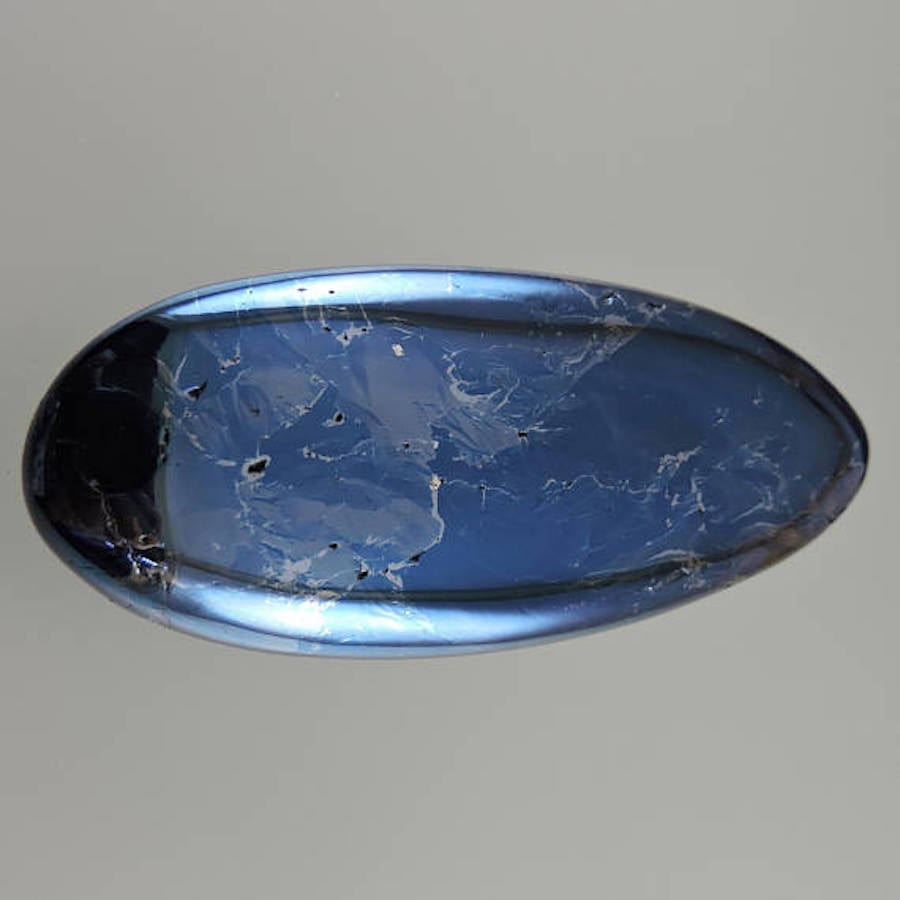Covellite Value, Price, and Jewelry Information
Although covellite has attractive blue colors and shows iridescence, this rare mineral is difficult to cut. You can scratch it with a fingernail! As cut gems, they're strictly curiosities for collectors.
1 Minute Read
Although covellite has attractive blue colors and shows iridescence, this rare mineral is difficult to cut. You can scratch it with a fingernail! As cut gems, they’re strictly curiosities for collectors.
Start an IGS Membership today
for full access to our price guide (updated monthly).Covellite Value
Does Covellite Make a Good Jewelry Stone?
Cut covellites (or covellines) have no great value. With hardness ranging from 1.5 to 2, coins and fingernails could scratch these gems. Although gem cutters have cut cabochons from this material, covellite would make a challenging jewelry stone.
Of course, just because a mineral doesn't make good rough doesn't mean it lacks beauty. Covellite's colors and iridescence can also be appreciated in its natural crystal form, too.
What is "Pink Fire" Quartz?
In 2005, quartz stones with covellite inclusions appeared on the market. This so-called "Pink Fire" quartz can show a pink flash when viewed from different angles due to these inclusions.
"Pink Fire" quartz, very light brown with pink flash, 32.77 cts, oval buff cushion, Brazil. © The Gem Trader. Used with permission.
Identifying Covellite Gems
Covellite's iridescence, color, and brassy inclusions of pyrite and chalcopyrite can help distinguish it visually from gems within its hardness range.
Covellite leaves a shining, gray-black streak. (Usually, metallic gems, like this copper sulfide, have a colored streak). You'll likely have no occasion to conduct a destructive streak test for identification purposes. However, if you want to see firsthand one of the few gems to leave a non-white, non-colorless streak, use a small spare piece or test a piece on an inconspicuous spot.
Are There Synthetic Covellites?
Covellites have some unusual structural and electrical properties of interest to science and industry. This mineral is a naturally occurring superconductive material. Not surprisingly, researchers have synthesized it, but use of this synthetic material for jewelry or other adornment is unknown (and unlikely, given its softness).
Where is Covellte Found?
The type locality for this gem is the infamous Mount Vesuvius. Italy, principally Sardinia, remains an important source of gem-quality material.
Other notable sources include the following:
- United States: Alaska; California; Colorado; Butte, Montana; South Dakota; Utah; Wyoming.
- Argentina; Australia; Bosnia-Herzegovina; Germany; New Zealand; Philippines; Serbia.
Stone Sizes
Gem cutters generally cut cabochons from massive or foliated material. As a result, the cabs can be very large, up to several inches long.
Caring for Covellite Gems
You're more likely to find covellites, if at all, in mineral collections than in jewelry collections. Jewelry use isn't recommended. Consult our gemstone jewelry cleaning guide for care recommendations.
Joel E. Arem, Ph.D., FGA
Dr. Joel E. Arem has more than 60 years of experience in the world of gems and minerals. After obtaining his Ph.D. in Mineralogy from Harvard University, he has published numerous books that are still among the most widely used references and guidebooks on crystals, gems and minerals in the world.
Co-founder and President of numerous organizations, Dr. Arem has enjoyed a lifelong career in mineralogy and gemology. He has been a Smithsonian scientist and Curator, a consultant to many well-known companies and institutions, and a prolific author and speaker. Although his main activities have been as a gem cutter and dealer, his focus has always been education. joelarem.com
International Gem Society
Related Articles
Black Diamond Value, Price, and Jewelry Information
Chameleon Diamond Value, Price, and Jewelry Information
Gray Diamond Value, Price, and Jewelry Information
Green Diamond Value, Price, and Jewelry Information
Latest Articles
Basic Business Rules: Buying Rough
Peridot Value, Price, and Jewelry Information
Traditional Diamond Cut Grading Methods
Cutting a 294-ct Trilliant Morganite: An Interview with Steve Moriarty
Never Stop Learning
When you join the IGS community, you get trusted diamond & gemstone information when you need it.
Get Gemology Insights
Get started with the International Gem Society’s free guide to gemstone identification. Join our weekly newsletter & get a free copy of the Gem ID Checklist!
